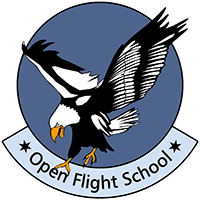Basics for Radio Communication
5. Basic Radio Calls
The subject of radio is a bugbear for most beginners, because they find the amount of different terms and radio calls overwhelming. In addition, there are some players who shy away from modern radio because they have had little to no previous exposure to English.
For these reasons we have decided to use only a few and partly shortened radio messages in the basic courses. In later courses, more phrases will be added, or the already known ones will be supplemented with further information. Therefore, you will only have to get used to the system for a short time and you will not have to learn everything again. We also accommodate our flight students with regard to the language. All phrases may also be spoken in German. However, every student pilot must at least understand the English phrases. But no further effort is necessary, because you learn them automatically because you hear them again and again.
It is important to share information. Even if the form and wording of a radio message does not correspond to the procedures, but the information itself is correct, that is still 100 times better than saying nothing at all!
Example:
"Kaltokri now taxiing to Kutaisi runway" contains all the important information. Of course "Kutaisi Airspace, Eagle-1, Taxiing to Runway 26" or "Kutaisi Traffic, Eagle-1, Taxiing to Rwy 26" is better.
But saying nothing and taxiing because you can't think of the right phrase is worse.
In the basic courses, there is no human air traffic controller (ATC) to interact with by radio. This greatly simplifies the radio process. In later courses, however, radio communication with human ATC is also practised.
Syntax
First, let's take a closer look at the components of a radio message.
Here is an example:
<Kutaisi> Traffic, <Eagle-1>, East Entry, 6,000 feet, to Land
<Kutaisi> Traffic
- This is the recipient to whom the message is addressed. (Who is called?).
Kutaisi is the name of the airfield. The angle brackets indicate that you may need to change the name of the aerodrome here.
- Traffic addresses all aircraft in kutaisi airspace. The word Traffic is used instead of Tower when no human ATC is available..
<Eagle-1>
- This is the sender of the message (Who am I?).
- This is your identifier which can be found in the mission briefing.
- For carrier operations, one speaks of Modex (number on the bow, e.g. 101).
- For land-based operations, it is the callsign (Roman 1-1, etc.).
- It does not necessarily have to match the in-game callsign (e.g. Enfield 1-1).
- If you have two numbers, the first is for the flight and the second is for your position in the flight.
- You also have to adapt this to the situation.
East Entry, 6,000 feet
- This is your location (Where am I?).
- The information consists of the position (absolute or relative position) and the height.
- Absolute position: There are certain fixed points in the approach charts, e.g. East Entry.
- Relative Position: For example 15 miles South of Kutaisi. So 15 miles south of Kutaisi.
- In the basic course we kept the use of the location to a minimum. Later you will use it more often.
- This is important for others to be able to assess where you are at the moment.
To Land
- This is the radio message (What do I want?).
- In this example, it is the announcement that you intend to land.
